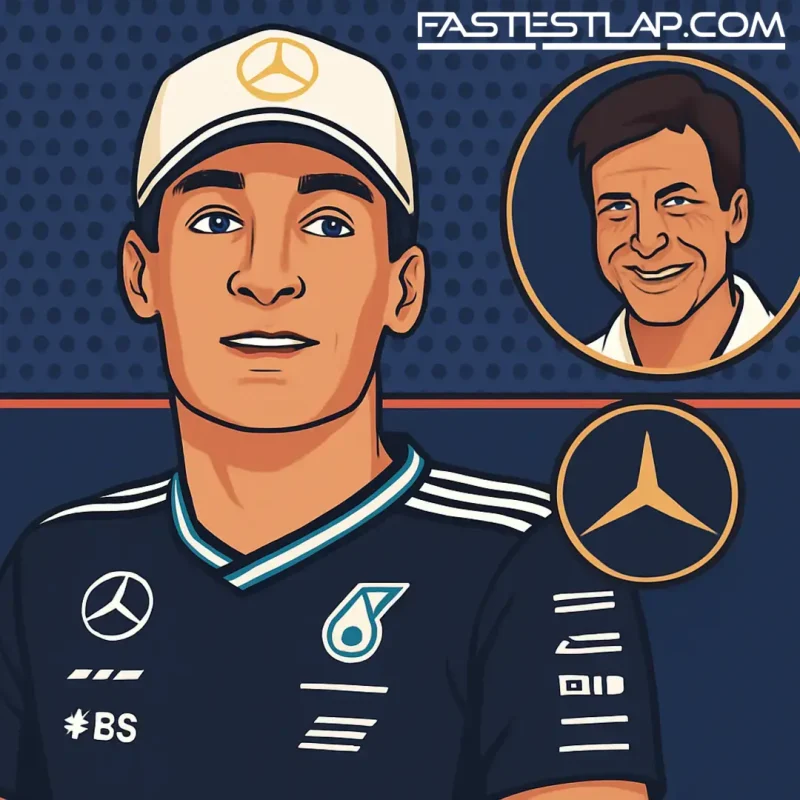George Russell’s “non-announcement” says plenty about Mercedes talks
George Russell arrived in Singapore with the look of a man who’s done this dance before. Ask about his Mercedes future, get the same answer: nothing’s signed, nothing’s slipping, and nothing’s especially dramatic.
“There’s no date to give you,” he said, batting away yet another round of contract questions. “It’ll get done when it gets done.” No hints, no fuss, and certainly no panic.
Both Russell and Kimi Antonelli are out of contract at season’s end, and Toto Wolff has been pretty clear about where he wants this to go as F1 heads for the 2026 reset: keep both. “We’re continuing with both of them,” he said recently, the kind of line delivered with a shrug that suggests this isn’t meant to be a saga.
Yet here we are, edging deeper into autumn with a deal still unsigned, and the paddock can’t help itself. Word is the sticking points aren’t whether Russell stays, but how he stays: the workload off-track, the travel schedule, the sponsor days, and—crucially—the length of the commitment. Classic modern F1 contract stuff.
You don’t need to be a seasoned spotter to understand the leverage. Russell is an established race winner and the team’s reference point. He’s also at the stage of his career where the next signature shapes everything that follows. He wants a proper multi-year runway. Mercedes, whisper the paddock operators, would like optionality—call it one-plus-one, call it an escape hatch—because there’s a certain three-time world champion who might be movable for 2027. Whether that’s concrete or just Wolff playing the long game, it lingers over every conversation.
“If the debate is about media and marketing days, that’s one thing,” was the gist from TV pundits this week. “If it’s about only one year to leave a door open for Max Verstappen, that’s another.” You can see why that narrative grabs headlines; it’s neat, it’s dramatic, and it’s exactly the sort of chess move we’ve seen Mercedes flirt with before.
Strip that away and the situation feels more mundane. Wolff has already said the team and Russell are aligned on trimming the noise around the job—long-haul commitments, sponsor activations, the stuff that drains performance more than it adds. That’s perfectly normal when a driver graduates from young-gun to team leader. And on the other side, why wouldn’t Mercedes want room to maneuver as the 2026 rules come into play?
Russell, for his part, isn’t entertaining the theatre. Asked if he’s turned into a “tough negotiator,” he smiled it off. He wants a fair, mutual deal. He’s been bouncing between Brackley and Brixworth, maxing out the simulator, doing the grind. No signs of a standoff, no appetite for brinkmanship. He even joked that if he somehow ended up contract-less over winter, so be it—but he doesn’t expect it.
It’s also worth remembering where Mercedes are in their own arc. With 2026 looming and the team’s driver pairing settled for 2025—Russell alongside rookie Kimi Antonelli—the smart money says they’ll lock continuity. A rebuild around regulations this big isn’t when you gamble on empty seats. And on that, Wolff has sounded unequivocal: he wants both current drivers into the new era.
So, what’s really going on? Likely a little of everything. Russell’s camp is pushing for term and a lighter commercial burden; Mercedes is safeguarding flexibility without spooking its team leader. Both sides know they want the same outcome, and both sides know time isn’t their enemy. This is the F1 contract paradox: the less there is to say, the more everyone wants to say it.
The only real hazard here is perception. If you’re Russell, you don’t want to feel like a placeholder for someone else’s fantasy signing. If you’re Mercedes, you don’t want your No.1 to feel like anything but central to the project. That’s where Wolff’s messaging has been deliberate—publicly backing Russell and Antonelli, privately working the fine print.
Read past the noise, and it’s straightforward: expect a multi-year deal to emerge, perhaps with optionality that keeps Mercedes nimble. Expect Russell’s diary to slim down. Expect the story to wrap before winter testing without so much as a press-room drum roll. And then expect the next round of questions to pivot to 2026—and whether Mercedes can give Russell the car to match the responsibility he’s taken on.
Until then, this “non-announcement” is the most F1 thing imaginable: a lot of talk around a decision everybody already knows.




